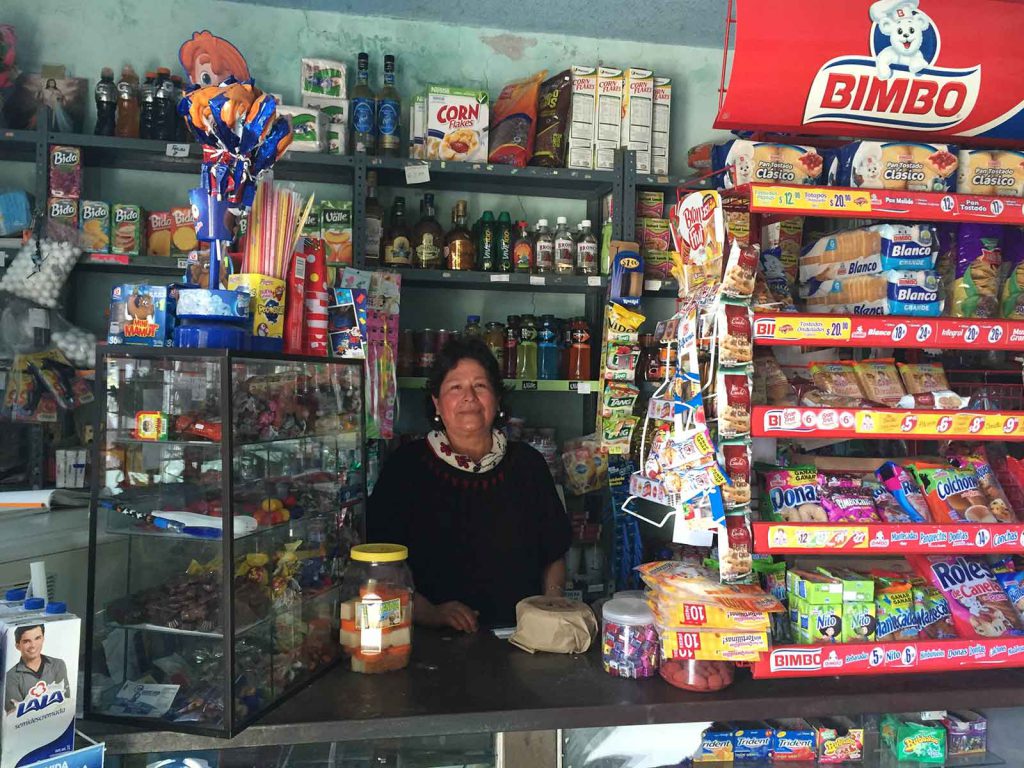The Illusion and Peril of Food “Choice”

When María (a pseudonym) was diagnosed with gestational diabetes during her first pregnancy, and again during her second, some might have blamed it on her food choices or lifestyle. She blamed it on her broken heart.
Having migrated to the Bronx in the mid-1990s from rural Puebla, a state in Mexico, María was separated from her mother back in Mexico. Immigration status kept them from being able to see each other. She knew that if she had been in her hometown, her mother would have lovingly nurtured her throughout her pregnancies, preparing home-cooked meals and drawing on a wealth of remedies for every ache or pain. Instead, María suffered in silence. Sadly, her mother was also suffering: She, too, had been diagnosed around 2010 with the initial symptoms of diabetes. But within a few years, the disease would rage out of control, causing her kidneys to fail, her leg to be amputated, and, within a decade, her death. Lacking any known genetic predisposition to diabetes, María and her mother saw the disease as a product of their estrangement.
Global health experts are clear that noncommunicable diseases, such as diabetes, heart disease, and kidney disease, are a critical threat to humanity, causing 72 percent of premature deaths in 2016. Conventional wisdom tends to blame these “diet-related chronic diseases” on individual behavior, specifically food choices and exercise. Even some who suffer from them tend to blame themselves, imagining that if they had more discipline, ate better, or were more active, their health would improve.
While we all have the power to make changes that can improve our lives, the facile pointing of fingers at the victims of chronic disease overlooks all the important factors that are not directly under our control to change: our food system and the larger social, political, and economic landscapes in today’s globalized society. Human appetites and exercise have changed less in the last quarter century than our food systems and economic arrangements. Globalization has enabled a near total diffusion of industrialized and processed foods into the most economically and socially marginalized places in the world, while also disrupting agrarian ways of life and small-scale agriculture.
More people than ever are on the move globally—like María, they are often displaced from their home communities, their land, and their extended families, and impeded by borders. These changes not only wreak havoc on eating habits, they also generate stress and trauma, which have been shown to play major roles in the onset and progression of chronic diseases.
Blaming personal behavior is just a convenient evasion. The mismatch between “bad” foods that move freely—and people who cannot—is the real culprit behind a global health crisis.
We are cultural anthropologists who have been studying the relationship between migration and health for two decades. In The Unending Hunger: Tracing Women and Food Insecurity Across Borders, Carney has examined the ways that food insecurity, or a lack of access to nutritious and culturally appropriate foods, shapes women’s migration from Mexico and Central America to the United States. Gálvez wrote about the health consequences of the 1994 North American Free Trade Agreement (NAFTA) in her recent book Eating NAFTA: Trade, Food Policies, and the Destruction of Mexico.
Our research has led us to understand the ways that globalization has brought industrialized food to all, while undermining people’s livelihoods. These disruptions to local food and economic systems are, we believe, some of the biggest drivers of noncommunicable chronic diseases.
In the past, researchers focused on the fact that when migrants come to the United States, they often adopt the “standard American diet”—a diet defined by excess consumption of calories from refined carbohydrates, fatty meats, and added fats, and one that lacks many nutrients found in whole grains, fruits, and vegetables. This diet triggers a decline in their health; the longer migrants are in the U.S., the worse their health tends to be. But today, we see that this “dietary acculturation” does not require migration—people in communities around the world are increasingly eating “like Americans.” Because of the global distribution channels permitted by technology, infrastructure, and food preservation, there are few places in the world without access to cheap industrialized food.
Emerging research has also shown that even our gut microbes are affected by moves from rural to urban areas and from developing to industrialized places. People in heavily industrialized places who eat highly processed foods have a lower diversity of gut microbes than those in rural areas who eat traditional diets. A loss of biodiversity in the gut has been associated with weight gain. And recent studies show that immigration triggers reduced gut biodiversity, perhaps precipitating the onset of metabolic diseases. We can imagine that gut bacteria, like diets, are transforming in rural places where diets, even without migration, are now more industrialized.
But to understand the root cause of these diseases, we need not zoom in to the microscopic, peering for clues inside our microbiomes, the collective microorganisms that live inside us, as though they were separate from the world we live in. We need to zoom out to the macroeconomic and social forces at play.
Human appetites for fats, salts, and sugars are age-old and evolutionarily driven. Highly processed foods cater to our predisposition to these, without delivering nutrition. Only in the contemporary era has it been common to simultaneously consume an excess of calories and remain nutritionally deficient, since so many processed foods are engineered to deliver a flavor punch without the micronutrients that unprocessed foods possess. Likewise, only today can we see these same foods contribute to a decline in gut biodiversity.
As awareness of the negative health impact of processed foods grows, food and beverage companies look for new places and ways to sell their products. Sometimes corporations even collaborate in projects to address hunger and malnutrition while simultaneously contributing to the transformation of food systems that produce these conditions. Mexico’s National Crusade Against Hunger, for instance—a development project focused on eliminating hunger and food insecurity—has multinational food corporations at the helm. Author and activist Andrew Fisher calls these companies and their “unholy alliance” with food aid “big hunger,” comparing their perverse economic motivations to those of the “big pharma” multinational drug companies. Corporate interests are privileged in economic and social policies, including government-sponsored and private food assistance, and also trade deals.
Trade deals like NAFTA (now the United States-Mexico-Canada Agreement [USMCA]) lower the costs and risks that massive food distribution networks face, leaving small-scale farmers without the capacity to get their goods to market or to compete in global markets. Basic staples have less of a profit margin than industrialized food products. The result is that for people like María’s mother, as her diabetes advanced, she had easier access to processed and packaged foods that are less nutritious than to her hometown’s locally grown produce. Because of these transformations in the food system, most local farmers either migrated to the United States after NAFTA was initiated or shifted to other kinds of work, since new economic arrangements mostly favored large corporate interests and led to new inequalities. State-subsidized distribution systems for farm produce were eliminated.
Economic agreements, such as the USMCA, eradicate the subsidies, price supports, and distribution channels that once helped buffer market forces so that food producers and consumers could find each other at a price that was worthwhile for both. So, while the U.S. famously retains its massive subsidies for commodity grains like corn, producing a surplus that mainly gets used for junk—from corn starches to artificial animal feeds, snack foods, and ethanol—farmers who grow corn or vegetables on a small scale can’t compete.
Migrants are often on the move precisely because of the resulting global economic arrangements: loss of access to land, changing economic opportunities, and a need to relocate to find the means to survival. They are more exposed, perhaps, than anyone else to globalized food systems; they are more likely than others to be employed by, and dependent on, these systems for their food needs. But while the borders are open to food exports and imports, they are often officially closed to these people.
Many immigrants to the U.S. that we have interviewed marvel that fruit and vegetables are pricier than meat, soda, or snack foods. By contrast, in places with robust agricultural economies and few international trade deals, naturally grown food is the cheaper staple. Since immigrants are more likely to work in low-paying sectors, they skimp on fresh foods and look for items that offer the biggest bang for their buck, such as processed foods high in carbohydrates, sugar, and sodium that deliver the most calories for the lowest price. Carney has found that food insecurity is one of the most common motivations for migration from Latin America, but migration does not resolve it, as even migrants living and working in and near the most affluent U.S. communities often remain food insecure. This is especially so among those employed in agriculture, food production, and food preparation.
These stressors, along with navigating increasingly hostile attitudes toward immigrants and the rising threat of detention and deportation, wreak havoc on the body. “Weathering”—the way the body responds to cumulative disadvantage and discrimination—takes a toll, affecting endocrinological, metabolic, and immune systems, and accelerating the onset and progression of disease.
If we are concerned about global health, and in particular the health of migrants coming to the U.S., we need to stop blaming people for eating poorly and recognize the broader forces that shape people’s food choices and health. We need to correct the mismatch: advocating for immigration reform so that a changed economic landscape does not tear families apart, creating policies that regulate junk food and support traditional foods, and limiting the capacity of corporations to distribute harmful products around the globe.


































